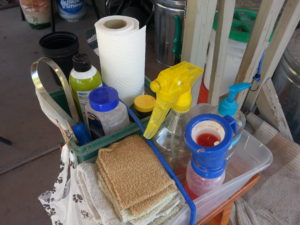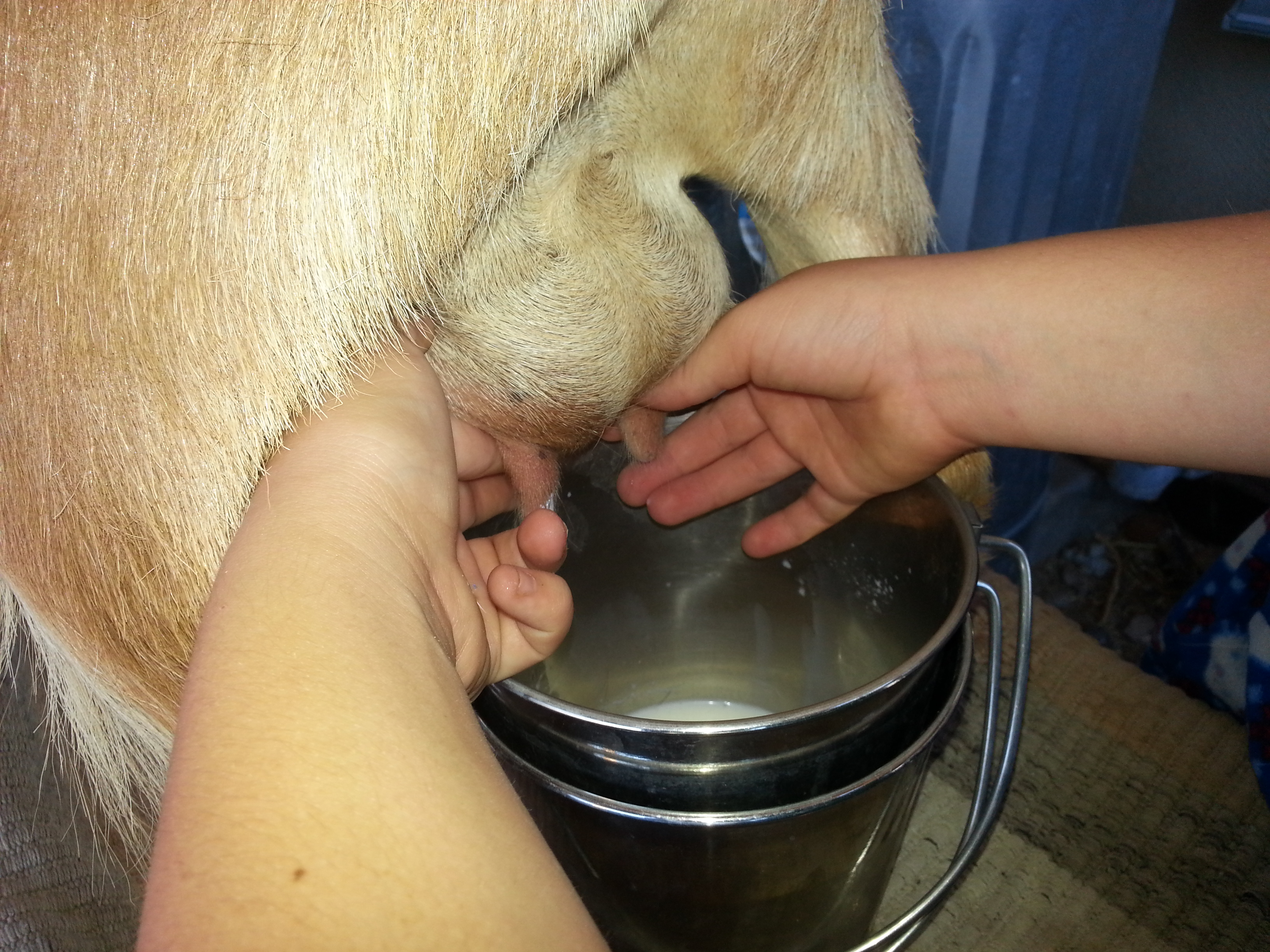Fresh, raw goat milk is both delicious and healthy, and milking goats is fun! But drinking raw milk can be risky if it is not done carefully, using proper hygiene. At our farm, The Micro Farm Project, my youngest daughter, Emily, and I milk several goats each day.
My first recommendation to new and prospective dairy goat owners is to purchase stock from a reputable breeder and a CAE free herd. CAE stands for Caprine Arthritis Encephalitis, a virus that affects goats, but not humans. CAE is spread via infected milk, colostrum, or blood. The viral infection is associated with acute weight loss, mastitis, pneumonia, encephalitis, and most often, with arthritis. Many goats that are infected with CAE show no symptoms, but they can pass the virus on to their offspring. Since dairy goats must be freshened, or give birth, periodically in order to produce milk, CAE infections are bad news for a dairy herd. Reputable goat breeders regularly have their herds lab tested for CAE, and should be able to produce recent lab certificate verifying clean results.
Once you have brought your CAE dairy goat home, these are the steps to take to ensure clean, healthy milk on your farm. Note that these instructions do not apply to commercial operations and are not intended to be professional recommendations. These instructions come from my observations and experience. Do your own research prior to drinking raw milk.
Instructions:
1. Keep your goat enclosure clean and tidy. Goats poop a lot! And they will often lie down in soiled areas, placing their udders right on the dirty ground. Removing manure daily and providing fresh, dry bedding a couple of times per week will reduce germs and flies, too! Providing raised areas on which goats can rest will help to keep their udders clean.
2. Be prepared. Come up with a system so that your equipment is ready to go when you need it. My system was to wash my equipment and get it ready for the next day immediately after I finished milking. If I put it off, sometimes I was scrambling to do it in the morning.
3. Keep a clean milking area. The milk stand, floor, tables and other areas should be swept and washed regularly. On our farm, we milk outdoors, and the biggest risk of germs seems to come from birds who sit on our equipment, looking for stray pieces of goat feed. Sweeping up spilled feed and washing off bird poop is a must.
4. Wash your hands with soap. This may seem like a no-brainer, but this step is critical to clean milking. Using soap and hot water, scrub your hands for at least one minute, scratching your fingertips on your palm to clean nails and cuticles. And speaking of nails, I recommend keeping them short. If you must have long nails, wear a fresh pair of disposable or surgical gloves each time you milk.
5. Clean your doe’s udder. At The Micro Farm Project, we keep an array of supplies by the milk stand to keep everything very clean. Our routine is as follows:
When a doe is brought to the milk stand, she is first brushed to remove stray hairs. Her udder, teats and back legs are sprayed with food grade hydrogen peroxide and wiped with a clean cloth. Antibacterial gel is applied to our hands, and milking begins.
6. Discard the first squirt of milk. Goat milk is naturally sterile in the udder, but can be contaminated if germs are present in the teat. By discarding the first pull of milk from the teat, germs are flushed and risk of contamination is reduced. Have a container, or strip cup, handy to facilitate collection and disposal of the first milk.
7. Milk into a clean, cold container. At our farm, we have two stainless steel buckets that we wash in extra-hot, soapy water daily. The buckets stack on top of one another. The bottom bucket is filled with a layer of ice cubes on which the top bucket rests. In this manner, milk is chilled immediately upon collection. This not only reduces the risk of spoilage, but keeps the milk tasting sweet and delicious. Milk that is allowed to get warm has more of a goaty or musky flavor.
8. When milking is complete, strain the liquid through a mesh coffee filter or milk filter to remove hair and debris. We milk our does one at a time, straining milk into jars in between and storing it in a cooler with ice until we are ready to take the jars inside and place them in the fridge.
 9. When milking is complete, clean the teats again. I recommend dipping teats in Fight Bac or Hibiclens using a non-return teat dip cup, like the blue one pictured here. An internet search will reveal a number of homemade teat dip recipes, but I personally prefer Hibiclens or other CHG (Chlorhexidine gluconate) treatment because it is non-irritating and when it dries, it seems to form a seal on the tip of the udder that prevents infection very effectively. After dipping each teat, excess cleanser is discarded and the goat is allowed to remain on the stand for a minute or two while the Hibiclens treatment dries. I use this time to scratch my does on the head and give them a treat as a reward for allowing me to milk them.
9. When milking is complete, clean the teats again. I recommend dipping teats in Fight Bac or Hibiclens using a non-return teat dip cup, like the blue one pictured here. An internet search will reveal a number of homemade teat dip recipes, but I personally prefer Hibiclens or other CHG (Chlorhexidine gluconate) treatment because it is non-irritating and when it dries, it seems to form a seal on the tip of the udder that prevents infection very effectively. After dipping each teat, excess cleanser is discarded and the goat is allowed to remain on the stand for a minute or two while the Hibiclens treatment dries. I use this time to scratch my does on the head and give them a treat as a reward for allowing me to milk them.
Hibiclens can be quite expensive, but it is cheaper than treating mastitis and the resulting loss of milk while the doe recovers. I dilute it 50% with water, and have very good results.
10. Store milk in sterile containers in the refrigerator. When milking is complete, we immediately date the jars with a grease pencil and rush them to the fridge. Milk lasts a week in our fridge easily with no change in quality. On the rare occasion that we don’t drink it within two weeks, I use it to make yogurt or cheese.
It may be my imagination, but I have found that if I scrub jars clean of any milk solids or residue prior to sterilization, milk lasts longer. Perhaps germs are able to survive the dishwasher by hiding in the residue.
11. Thoroughly wash milking equipment with hot, soapy water. Commercial detergents are available for purchase, and many home recipes are posted online. I wash and scrub my equipment with very hot, soapy water and air dry it on a rack. Every time I use the dishwasher, I throw my buckets and straining equipment in with the dishes and wash them on the extra hot setting.
The washcloths that I use to clean udders are washed in the clothes washer with a load of white clothing, using hot water, detergent and bleach. Each cloth is only used once before it is discarded in the dirty bin. I have a large number of cloths, purchased at the dollar store, so that I can collect a bunch of them before I have to run a load through the wash. I try to use bleach only on rare occasions, since I have a laundry-to-landscape system. Alternatively, you could use disposable paper towels.
12. Drinking raw milk has inherent risks, since it is not pasteurized to remove any harmful organisms that may be present. Research recommended hygiene methods to keep your raw milk safe for consumption, and avoid raw milk altogether if you have immune disorder or other health risks. For those of us who are reasonably healthy, drinking clean, raw milk is good for our bodies and so delicious. Enjoy!
How to Keep Raw Goat’s Milk Fresh and Delicious by Danelle Wolford of Weed ‘Em and Reap
Safe Handling of Raw Milk on the Kitchen Stewardship website
How to Handle Raw Milk…And Even Make It Last Longer by L. Larocque of Off the Grid News


